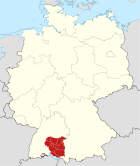Administrative region of Tübingen
| coat of arms | map |
|---|---|

|

|
| Basic data | |
|
|
| Administrative headquarters : | Tübingen |
| Surface: | 8,917.78 km² |
| Residents: | 1,856,517 (December 31, 2018) |
| Population density : | 208 inhabitants per km² |
| District structure: | 1 urban district and 8 rural districts with a total of 255 communities |
| Regional Council | |
| District President : | Klaus Tappeser ( CDU ) |
| Address of the regional council: | Konrad-Adenauer-Strasse 20 72072 Tübingen |
| Website: | Regional Council Tübingen |
| Location of the administrative district of Tübingen in Baden-Württemberg | |
The administrative district of Tübingen is one of four administrative districts in the German state of Baden-Württemberg .
It stands in the hierarchy above the rural and urban districts as well as under the state government , the regional council is thus a state middle authority .
geography
The administrative region of Tübingen is located in the south-east of Baden-Württemberg. Until December 31, 1972 it was called the administrative district of Südwürttemberg-Hohenzollern , but at that time it had a different layout. In the south it borders on Lake Constance , in the west on the administrative districts of Freiburg and Karlsruhe , in the north on the administrative district of Stuttgart and in the east on the administrative district of Swabia in Bavaria . Its current expansion goes back to the administrative and territorial reform on January 1, 1973.
history
The regional council of Tübingen has existed since the formation of the south-western state of Baden-Württemberg in 1952. Since then, the authority has essentially been responsible for the southern part of the former state of Württemberg and the former Prussian Hohenzollern Lands and for the former state of Württemberg-Hohenzollern (capital Tübingen ), which emerged from the French occupation zone after the Second World War . The administrative district was therefore initially called the administrative district of Südwürttemberg-Hohenzollern . During the regional reform, which came into force on January 1, 1973, the area of responsibility of the Tübingen regional council was expanded to include areas that were formerly Baden. In return, areas were also given to the Freiburg Regional Council. Therefore, the administrative district of Südwürttemberg-Hohenzollern was renamed the administrative district of Tübingen at the time .
Population development
The population figures are census results (¹) or official updates from the Baden-Württemberg State Statistical Office ( main residences only ).
|
|
organization
Supreme authority is the Regional Council Tübingen; Have been government presidents since 1973
- 1973–1975: Hans-Jörg Mauser
- 1975–1997: Max Gögler
- 1997-2006: Hubert Wicker
- 2006–2015: Hermann Strampfer
- 2015–2016: Jörg Schmidt
- since June 1, 2016: Klaus Tappeser
Administrative division
The administrative district includes
- 3 regions
- 8 rural districts and 1 urban district
- 255 cities and municipalities (including 1 municipality-free area ), including 1 urban district and 15 large district towns
The regions with their urban and rural districts :
- Neckar-Alb region
- District of Reutlingen (RT)
- District of Tübingen (TÜ)
- Zollernalbkreis (BL)
- Lake Constance-Upper Swabia region
- District of Ravensburg (RV)
- District of Sigmaringen (SIG)
- Lake Constance District (FN)
- Donau-Iller region (the cross-border region also includes areas in Bavaria)
- City of Ulm (UL)
- Alb-Danube District (UL)
- District of Biberach (BC)
The 16 major district towns (subject to the technical supervision of the regional council):
- Albstadt
- Balingen
- Biberach an der Riss
- Ehingen (Danube)
- Friedrichshafen
- Laupheim
- Leutkirch in the Allgäu
- Metzingen
- Mössingen
- Ravensburg
- Reutlingen
- Rottenburg am Neckar
- Tübingen
- Überlingen
- Wangen in the Allgäu
- Vineyard
economy
In comparison with the GDP per capita in the EU, expressed in purchasing power parity , the administrative district of Tübingen achieved an index of 134 (EU-28 = 100) (2015).
Web links
Individual evidence
- ↑ State Statistical Office Baden-Württemberg - Population by nationality and gender on December 31, 2018 (CSV file) ( help on this ).
- ↑ Eurostat. Retrieved August 22, 2018 .
Coordinates: 48 ° 0 ' N , 9 ° 30' E

